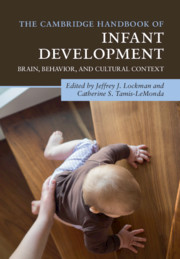Book contents
- The Cambridge Handbook of Infant Development
- The Cambridge Handbook of Infant Development
- Copyright page
- Dedication
- Contents
- Illustrations
- Contributors
- Preface
- Part I Foundations
- Part II Perceptual Development
- Part III Cognitive Development
- Part IV Action
- Part V Language
- 21 Infant Speech Perception
- 22 Infant Vocal Learning and Speech Production
- 23 Infant Word Learning and Emerging Syntax
- 24 Dual Language Exposure and Early Learning
- Part VI Emotional and Social Development
- Index
- References
22 - Infant Vocal Learning and Speech Production
from Part V - Language
Published online by Cambridge University Press: 26 September 2020
- The Cambridge Handbook of Infant Development
- The Cambridge Handbook of Infant Development
- Copyright page
- Dedication
- Contents
- Illustrations
- Contributors
- Preface
- Part I Foundations
- Part II Perceptual Development
- Part III Cognitive Development
- Part IV Action
- Part V Language
- 21 Infant Speech Perception
- 22 Infant Vocal Learning and Speech Production
- 23 Infant Word Learning and Emerging Syntax
- 24 Dual Language Exposure and Early Learning
- Part VI Emotional and Social Development
- Index
- References
Summary
During the first year of life, human infants undergo an extraordinary process of vocal learning, unmatched by other primates. This lays a key foundation for meaningful speech production. The first sections of this chapter describe major milestones and other features of the development of prelinguistic and early speech sounds, including the acquisition of new sound types and of conversational turn-taking skills. The chapter then discusses what we know about the roles of exploratory play, social input, and neural systems in human vocal learning. A section on computational modeling reviews theoretical work that informs our understanding of how these mechanisms interact. Effects of sociocultural and clinical differences on infant vocal development are then discussed. The final section of the chapter discusses policy perspectives on research and interventions in this domain.
Keywords
- Type
- Chapter
- Information
- The Cambridge Handbook of Infant DevelopmentBrain, Behavior, and Cultural Context, pp. 602 - 631Publisher: Cambridge University PressPrint publication year: 2020
References
- 4
- Cited by

